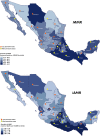Abortion legislation, maternal healthcare, fertility, female literacy, sanitation, violence against women and maternal deaths: a natural experiment in 32 Mexican states
- PMID: 25712817
- PMCID: PMC4342595
- DOI: 10.1136/bmjopen-2014-006013
Abortion legislation, maternal healthcare, fertility, female literacy, sanitation, violence against women and maternal deaths: a natural experiment in 32 Mexican states
Abstract
Objective: To test whether there is an association between abortion legislation and maternal mortality outcomes after controlling for other factors thought to influence maternal health.
Design: Population-based natural experiment.
Setting and data sources: Official maternal mortality data from 32 federal states of Mexico between 2002 and 2011.
Main outcomes: Maternal mortality ratio (MMR), MMR with any abortive outcome (MMRAO) and induced abortion mortality ratio (iAMR).
Independent variables: Abortion legislation grouped as less (n=18) or more permissive (n=14); constitutional amendment protecting the unborn (n=17); skilled attendance at birth; all-abortion hospitalisation ratio; low birth weight rate; contraceptive use; total fertility rates (TFR); clean water; sanitation; female literacy rate and intimate-partner violence.
Main results: Over the 10-year period, states with less permissive abortion legislation exhibited lower MMR (38.3 vs 49.6; p<0.001), MMRAO (2.7 vs 3.7; p<0.001) and iAMR (0.9 vs 1.7; p<0.001) than more permissive states. Multivariate regression models estimating effect sizes (β-coefficients) for mortality outcomes showed independent associations (p values between 0.001 and 0.055) with female literacy (β=-0.061 to -1.100), skilled attendance at birth (β=-0.032 to -0.427), low birth weight (β=0.149 to 2.166), all-abortion hospitalisation ratio (β=-0.566 to -0.962), clean water (β=-0.048 to -0.730), sanitation (β=-0.052 to -0.758) and intimate-partner violence (β=0.085 to 0.755). TFR showed an inverse association with MMR (β=-14.329) and MMRAO (β=-1.750) and a direct association with iAMR (β=1.383). Altogether, these factors accounted for (R(2)) 51-88% of the variance among states in overall mortality rates. No statistically independent effect was observed for abortion legislation, constitutional amendment or other covariates.
Conclusions: Although less permissive states exhibited consistently lower maternal mortality rates, this finding was not explained by abortion legislation itself. Rather, these differences were explained by other independent factors, which appeared to have a more favourable distribution in these states.
Keywords: EPIDEMIOLOGY; GYNAECOLOGY; OBSTETRICS; PUBLIC HEALTH.
Published by the BMJ Publishing Group Limited. For permission to use (where not already granted under a licence) please go to http://group.bmj.com/group/rights-licensing/permissions.
Figures








Comment in
-
[Maternal mortality and abortion laws in Mexico: comments on the article by Koch and colleagues].Salud Publica Mex. 2018 Jul-Ago;60(4):382-383. doi: 10.21149/8973. Salud Publica Mex. 2018. PMID: 30137934 Spanish. No abstract available.
Similar articles
-
Maintaining rigor in research: flaws in a recent study and a reanalysis of the relationship between state abortion laws and maternal mortality in Mexico.Contraception. 2017 Jan;95(1):105-111. doi: 10.1016/j.contraception.2016.08.004. Epub 2016 Aug 18. Contraception. 2017. Retraction in: Contraception. 2019 Jan;99(1):71. doi: 10.1016/j.contraception.2018.11.017. PMID: 27546094 Retracted.
-
Women's education level, maternal health facilities, abortion legislation and maternal deaths: a natural experiment in Chile from 1957 to 2007.PLoS One. 2012;7(5):e36613. doi: 10.1371/journal.pone.0036613. Epub 2012 May 4. PLoS One. 2012. PMID: 22574194 Free PMC article.
-
The relationship between attendance at birth and maternal mortality rates: an exploration of United Nations' data sets including the ratios of physicians and nurses to population, GNP per capita and female literacy.J Adv Nurs. 2001 May;34(4):445-55. doi: 10.1046/j.1365-2648.2001.01773.x. J Adv Nurs. 2001. PMID: 11380711
-
Association between intimate partner violence and induced abortion in Cameroon.Int J Gynaecol Obstet. 2011 Feb;112(2):83-7. doi: 10.1016/j.ijgo.2010.08.024. Epub 2010 Dec 4. Int J Gynaecol Obstet. 2011. PMID: 21130443
-
Determinants of maternal mortality in the developing world.Aust N Z J Obstet Gynaecol. 1991 Feb;31(1):8-16. doi: 10.1111/j.1479-828x.1991.tb02754.x. Aust N Z J Obstet Gynaecol. 1991. PMID: 1872781 Review.
Cited by
-
Inequalities in access to and quality of abortion services in Mexico: Can task-sharing be an opportunity to increase legal and safe abortion care?Int J Gynaecol Obstet. 2020 Jul;150 Suppl 1(Suppl 1):25-33. doi: 10.1002/ijgo.13002. Int J Gynaecol Obstet. 2020. PMID: 33219993 Free PMC article.
-
The proposed legislation on termination of pregnancy does not protect women or children in Malawi and is not fit for the intended purpose: Christian Medical and Dental Fellowship position.Malawi Med J. 2017 Mar;29(1):70-72. doi: 10.4314/mmj.v29i1.18. Malawi Med J. 2017. PMID: 28567205 Free PMC article. No abstract available.
-
The Abortion Web Ecosystem: Cross-Sectional Analysis of Trustworthiness and Bias.J Med Internet Res. 2020 Oct 26;22(10):e20619. doi: 10.2196/20619. J Med Internet Res. 2020. PMID: 33104002 Free PMC article.
-
The impact of criminalisation on abortion-related outcomes: a synthesis of legal and health evidence.BMJ Glob Health. 2022 Dec;7(12):e010409. doi: 10.1136/bmjgh-2022-010409. BMJ Glob Health. 2022. PMID: 36581332 Free PMC article. Review.
-
Pregnancy Outcome Patterns of Medicaid-Eligible Women, 1999-2014: A National Prospective Longitudinal Study.Health Serv Res Manag Epidemiol. 2020 Jul 31;7:2333392820941348. doi: 10.1177/2333392820941348. eCollection 2020 Jan-Dec. Health Serv Res Manag Epidemiol. 2020. PMID: 32844103 Free PMC article.
References
-
- United Nations. Resolution adopted by the General Assembly: United Nations Millennium Declaration. 2000;55/2:1–9. http://www.un.org/en/ga/search/view_doc.asp?symbol=A/RES/55/2 (accessed 3 Apr 2014).
Publication types
MeSH terms
Grants and funding
LinkOut - more resources
Full Text Sources
Other Literature Sources
Medical
